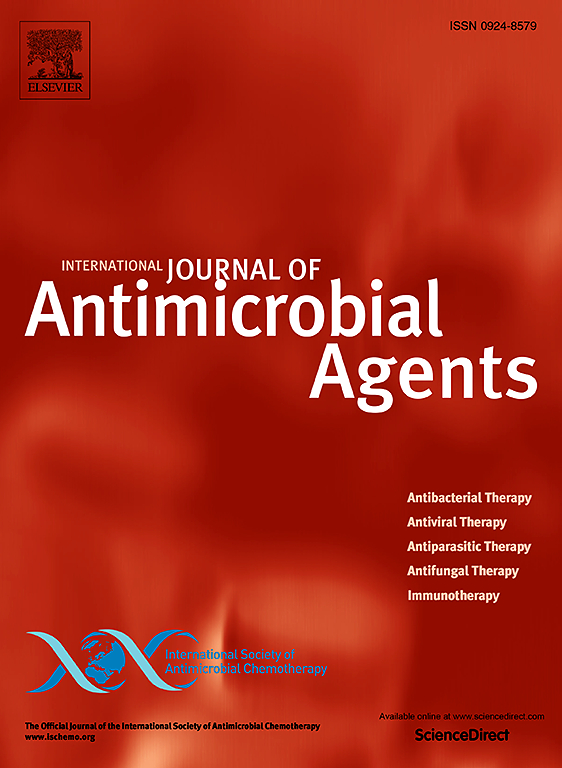黄酮醇通过抑制氧化应激诱导的细胞凋亡来中断内化细菌劫持细胞反应。
IF 4.6
2区 医学
Q1 INFECTIOUS DISEASES
International Journal of Antimicrobial Agents
Pub Date : 2025-08-20
DOI:10.1016/j.ijantimicag.2025.107595
引用次数: 0
摘要
内化细菌进化出多种手段来劫持细胞反应,并在上皮细胞中存活以引起持续感染。仅针对细菌的传统抗生素往往无法根除此类感染,这促使人们探索以宿主为导向的治疗方法,作为有希望的替代方法。然而,这些宿主定向干预的潜在分子靶点仍不清楚。在这里,我们提出的证据表明,三黄酮醇(杨梅素,山奈酚和槲皮素)表现出宿主定向抗菌活性,在对抗内化细菌。首先,与MBCEX相比,黄酮醇处理使MBCIN的变化下调了1倍,并使内化的金黄色葡萄球菌和肺炎葡萄球菌在肺上皮细胞内的定植减少了约80%。此外,利用网络药理学和转录组学相结合的方法来鉴定这些黄酮醇的潜在靶点,揭示它们抑制凋亡细胞死亡的能力。此外,黄酮醇处理可以减少活性氧(ROS)的产生,恢复内化细菌引起的线粒体膜电位(ΔΨm)的下降,从而减轻细菌内化引发的凋亡细胞死亡。黄酮醇的这些有益作用可能归因于其高酚羟基含量,杨梅素具有最多的酚羟基,表现出最明显的影响。最后,进一步的机制研究表明,黄酮醇通过体外和体内调节PI3K/Bcl-2和caspase-9/caspase-3级联来减轻凋亡细胞死亡。这些发现不仅突出了黄酮醇的宿主定向抗菌特性,而且强调了它们在对抗由内化细菌引起的持续感染方面的潜力。本文章由计算机程序翻译,如有差异,请以英文原文为准。
Flavonols interrupt internalized bacteria hijacking cellular responses via suppressing oxidative stress induced cellular apoptotic death
Internalized bacteria evolve multiple means to hijack cellular responses and survive in epithelial cells, causing persistent infections. Conventional antibiotics targeting bacteria alone often fall short in eradicating such infections, prompting the exploration of host-directed therapies as promising alternatives. Nevertheless, the potential molecular targets of these host-directed interventions remain unclear. Herein, we present evidence that three flavonols (myricetin, kaempferol, and quercetin) exhibit host-directed antibacterial activity in combating internalized bacteria. First, flavonol treatments downregulated one-fold changes of intracellular minimum bactericidal concentration (MBCIN) compared to extracellular minimum bactericidal concentration (MBCEX) and reduced about 80% intracellular colonization of internalized Staphylococcus aureus (S. aureus) and Streptococcus pneumoniae (S. pneumoniae) in lung epithelial cells. Furthermore, a combined approach using network pharmacology and transcriptomics was utilized to identify potential targets of these flavonols, revealing their ability to inhibit apoptotic cell death. Moreover, flavonol treatments were found to decrease reactive oxygen species (ROS) production and recover the decrease in mitochondrial membrane potential (ΔΨm) caused by internalized bacteria, thereby attenuating apoptotic cell death triggered by bacterial internalization. These beneficial effects of flavonols are likely attributed to their high phenolic hydroxyl group content, with myricetin, which has the greatest number of phenolic hydroxyl groups, exhibiting the most pronounced impact. Finally, further mechanistic research has revealed that flavonols mitigate apoptotic cell death through the modulation of PI3K/Bcl-2 and caspase-9/caspase-3 cascades in vitro and in vivo. These findings collectively not only highlight the host-directing antibacterial properties of flavonols but also emphasize their potential in combating persistent infections initiated by internalized bacteria.
© 2025 The Author(s). Published by Elsevier Ltd on behalf of International Society for Antimicrobial Chemotherapy.
求助全文
通过发布文献求助,成功后即可免费获取论文全文。
去求助
来源期刊
CiteScore
21.60
自引率
0.90%
发文量
176
审稿时长
36 days
期刊介绍:
The International Journal of Antimicrobial Agents is a peer-reviewed publication offering comprehensive and current reference information on the physical, pharmacological, in vitro, and clinical properties of individual antimicrobial agents, covering antiviral, antiparasitic, antibacterial, and antifungal agents. The journal not only communicates new trends and developments through authoritative review articles but also addresses the critical issue of antimicrobial resistance, both in hospital and community settings. Published content includes solicited reviews by leading experts and high-quality original research papers in the specified fields.

 求助内容:
求助内容: 应助结果提醒方式:
应助结果提醒方式:


